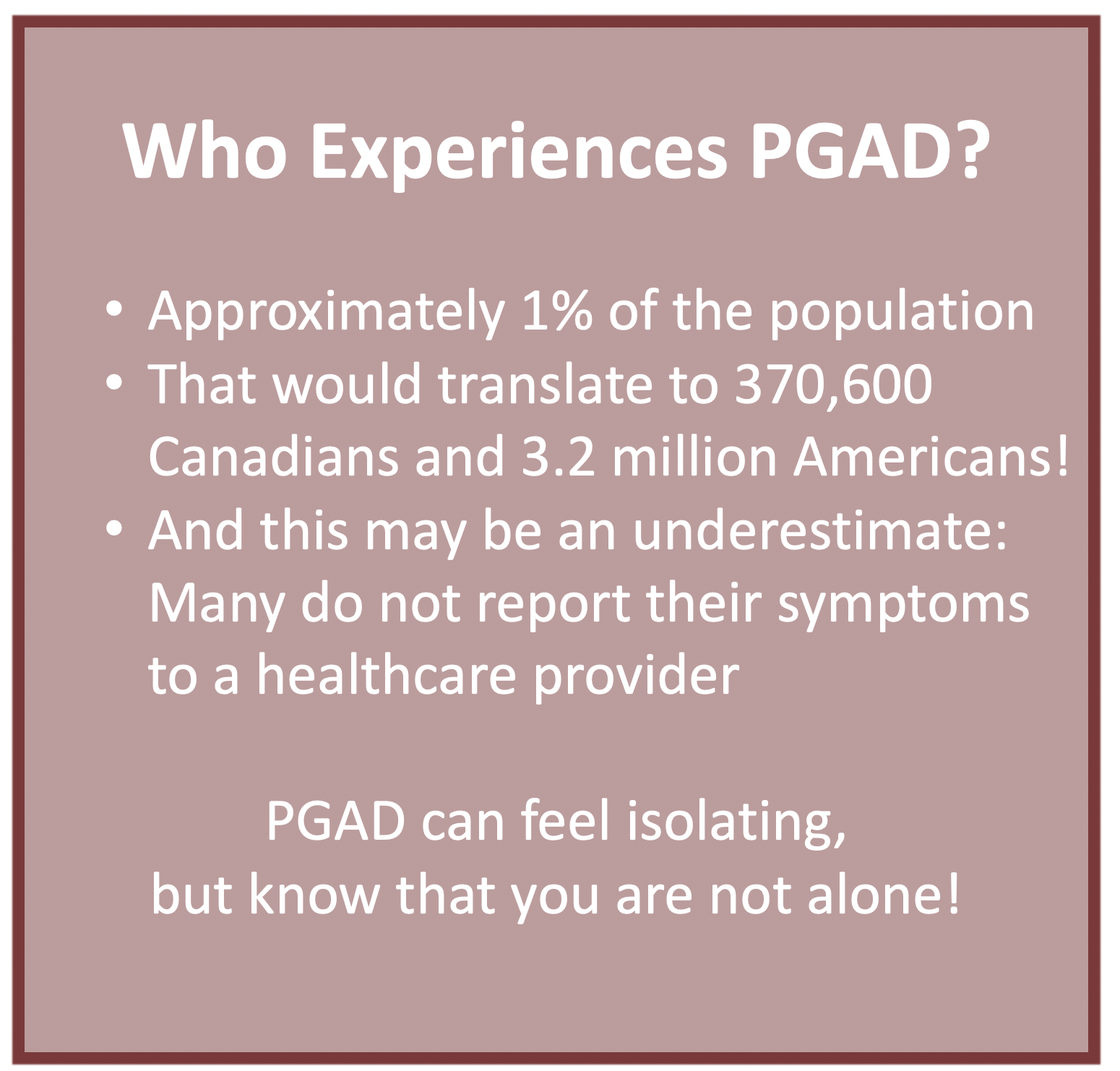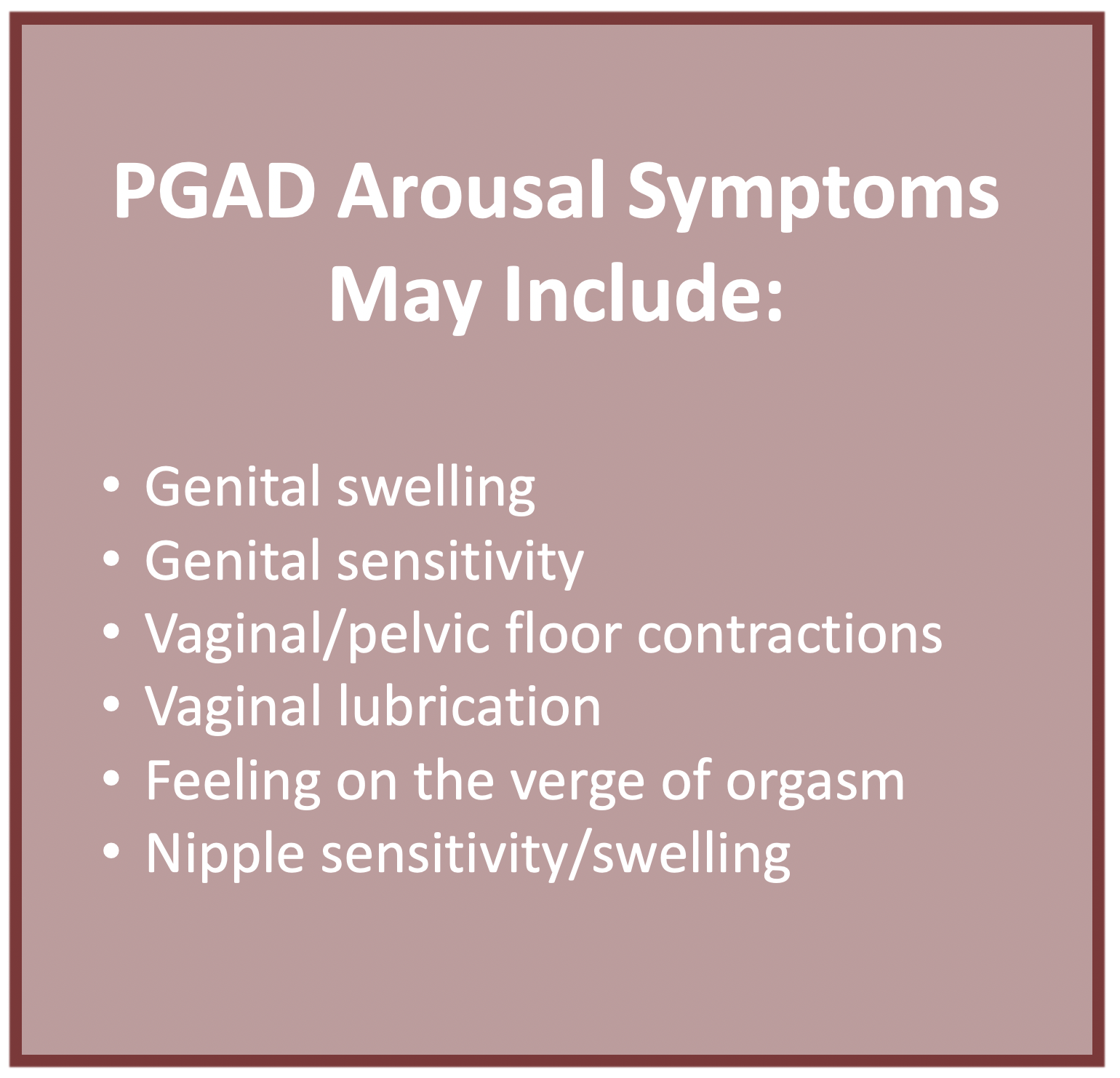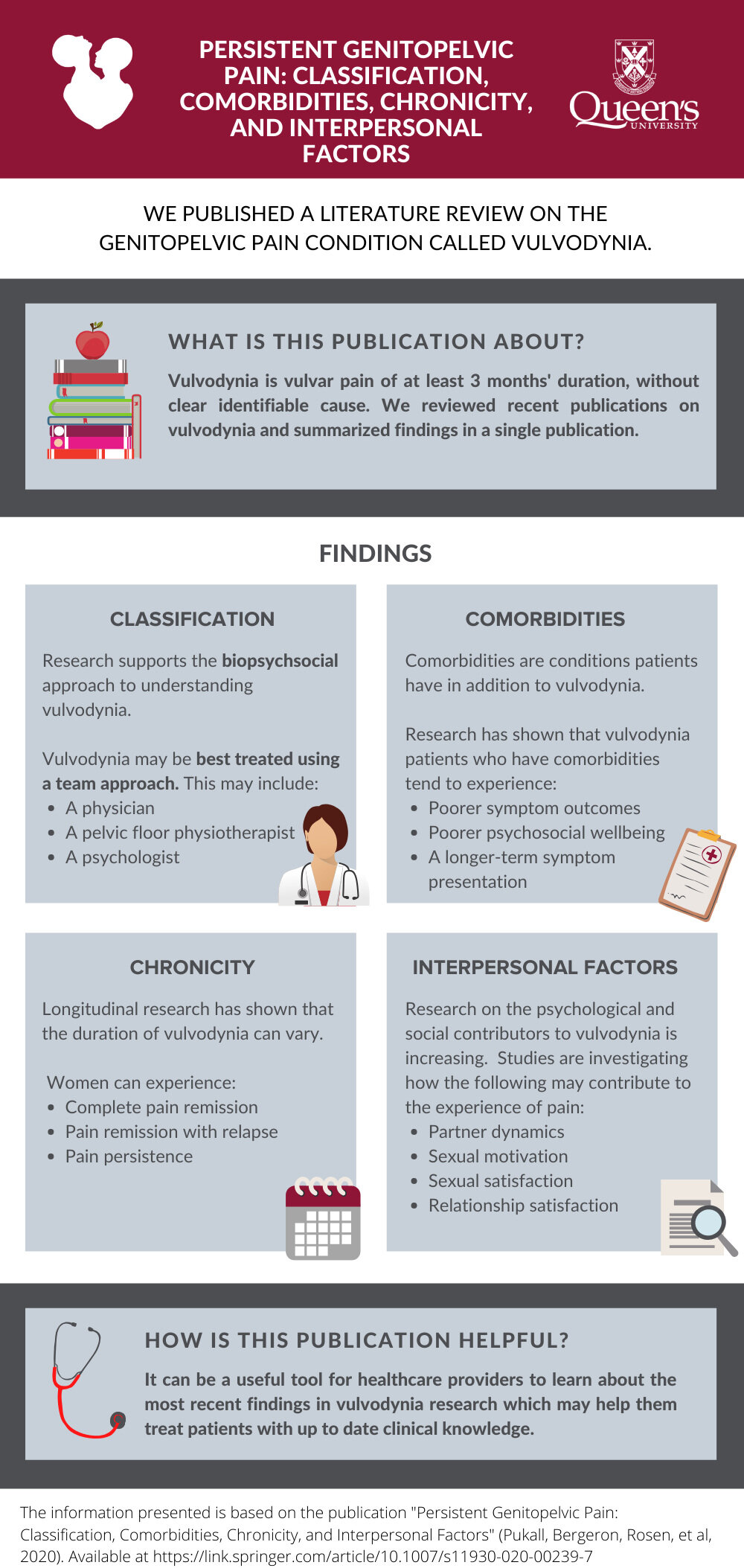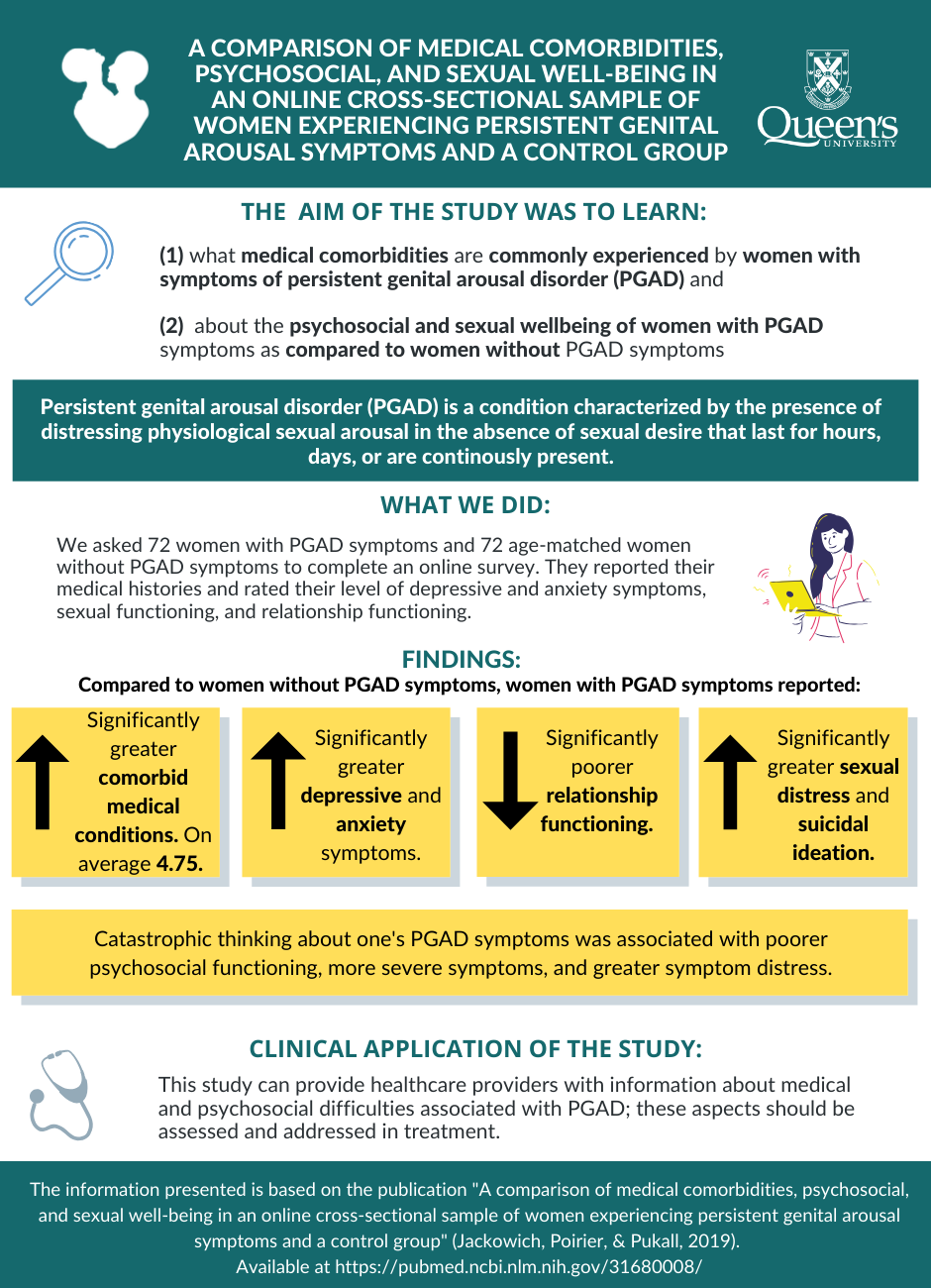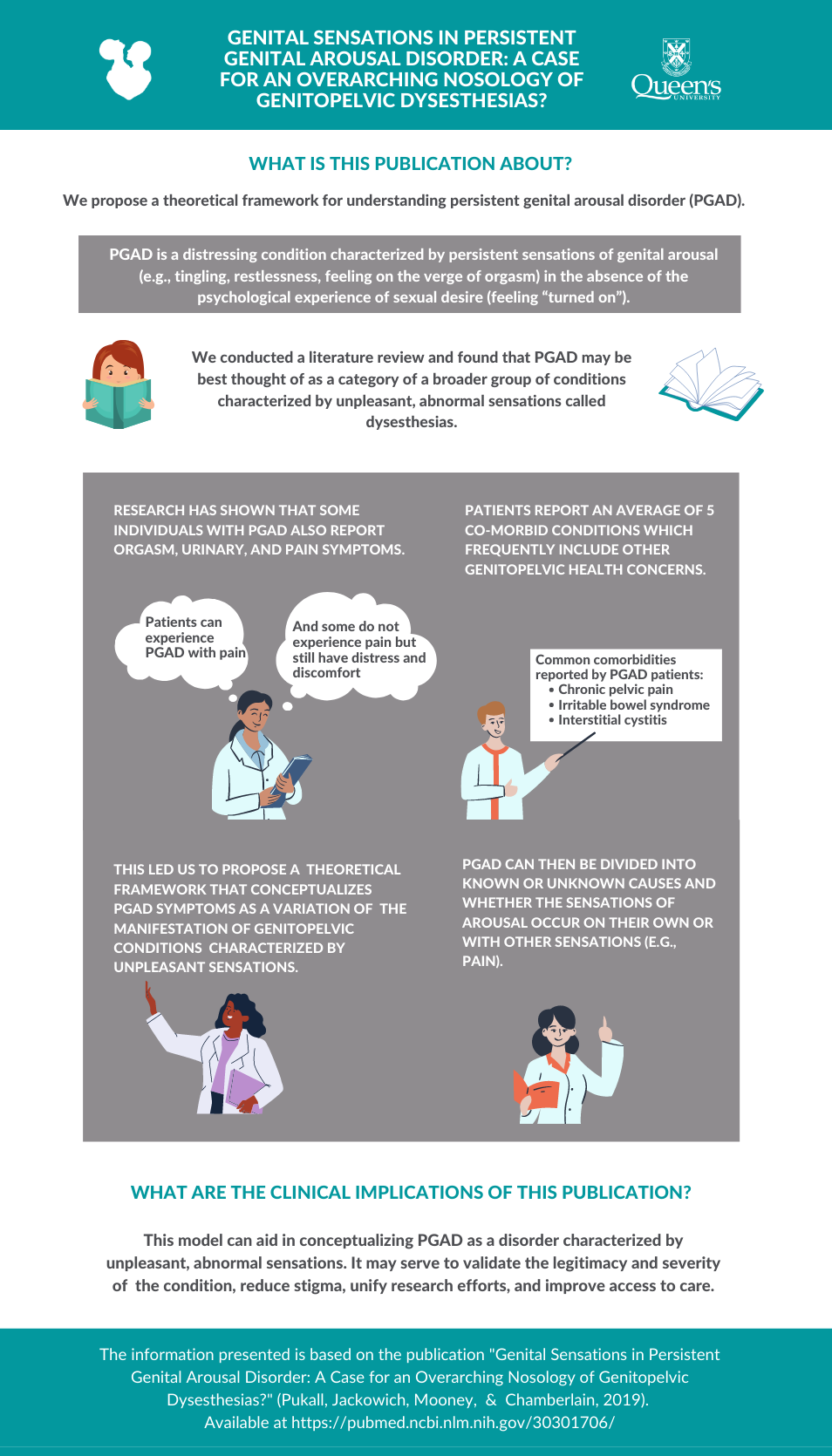Download our NEW brochure: PERSISTENT GENITAL AROUSAL DISORDER: A PRIMER FOR HEALTHCARE PROVIDERS
What is Persistent Genital Arousal Disorder?
Persistent genital arousal disorder (PGAD) is a health concern that has not yet received much research attention or recognition in the healthcare system. Individuals who experience PGAD report genital arousal symptoms (including sensitivity in their genitals, feelings of genital arousal—like tingling, throbbing, feeling on the verge of orgasm, swelling, lubrication) without corresponding feelings of sexual desire. This can feel like there is a disconnect between what is happening between one’s body and mind.
These arousal symptoms also last for a prolonged period of time: for hours, days, or are always present. PGAD symptoms do not usually go away with an orgasm or two and are described as distressing, unwanted and sometimes painful.
Furthermore…
These symptoms occur without feelings of sexual desire or excitement and persist for a prolonged period of time (hours, days, or are constantly present).
Approximately a third of individuals with PGAD report experiencing spontaneous orgasms, in other words, an orgasm that occurs in the absence of sexual activity/contact (Jackowich et al., 2018, Leiblum 2006). These orgasms are described as uncomfortable, distracting, and disturbing.
PGAD symptoms can occur in the genital area and in the pelvic area more generally, including the bladder, and some report nipple sensations/erection as well (Jackowich et al., 2018).
Approximately half of those with PGAD describe their symptoms as painful (Pukall et al., 2019).
Help us better understand PGAD.
Click on the Participate link above to find out how you can participate in research!
But Doesn’t Arousal = Pleasure?
Not always!
For many individuals, the physical aspects of sexual arousal happen at around the same time as subjective feelings of sexual desire (or feeling ‘in the mood’ or ‘turned on’), but this is not always the case. For example, individuals who experience erectile dysfunction may experience subjective feelings of arousal/desire, without corresponding physical arousal (i.e., without an erection). PGAD is another example of when genital arousal and desire do not occur at the same time.
People also experience many other kinds of feelings of physiological arousal, for example, the increased heart rate after having exercised. Sometimes we have positive thoughts and feelings about these bodily sensations, like when we are on a rollercoaster. But in other situations, our thoughts or feelings about the same kinds of sensations are negative, for example, when writing a stressful exam, or running away from a bear! For individuals with PGAD, the persistent physical sensations of genital arousal are felt as intrusive, unwanted, and distressing.
Is PGAD The Same Things as Hypersexuality?
Often, individuals with PGAD report being misdiagnosed with hypersexuality, but these two conditions are very different. PGAD is characterized by persistent genital arousal sensations in the absence of desire; in contrast, hypersexuality is characterized by recurrent and intense sexual fantasies, sexual urges, and behaviour that are associated with personal distress, and impairment in important areas of functioning (such as one’s social or occupational responsibilities; Kafka 2009).
Individuals who experience hypersexuality may engage in sexual fantasies, urges, or behaviour in response to stress or negative moods, they may experience unsuccessful effects to reduce these fantasies, urges, or behaviours, and they may disregard the risk of harm associated with these behaviours to themselves or others.
Individuals with hypersexuality do not experience unwanted, persistent genital arousal sensations.
Click on the Resources link above for PGAD Resources near Kingston, Ontario.
How Long Do Symptoms Last?
Some individuals with PGAD report that their symptoms are present all of the time, whereas others experience symptom ‘flares’ that may last hours or days. Some experience a combination of these (i.e., symptoms that are constantly present but increase or decrease in intensity). The majority of individuals with symptoms of PGAD report that their symptoms started after a period of time where they were symptom-free. Approximately 10% of individuals describe that they have experienced symptoms from as early as they could remember (Jackowich et al., 2018).
What Causes PGAD?
Unfortunately, little is known about what causes PGAD, and more research is needed to better understand the cause (or causes) of this condition. There are likely multiple factors that contribute to the expression of PGAD (Jackowich et al., 2016; Komisaruk & Goldstein, 2017).
Although more research is needed to understand PGAD symptoms, and their cause, it is important to know that these symptoms are not ‘all in your head’. They are real.
What Other Health Conditions are Associated with PGAD?
Individuals with PGAD often (but not always!) report experiencing other kinds of genitopelvic pain (like irritable bowel syndrome, interstitial cystitis, vulvodynia, pelvic pain), restless leg syndrome, overactive bladder, or chronic pain (Jackowich et al., 2018).
How Can PGAD be Treated?
PGAD can have a significant impact on the psychological, physical, and social wellbeing of those who experience these symptoms (Jackowich et al., 2018; Carvalho et al., 2013).
Unfortunately, we do not yet have very much research looking at the effectiveness of different treatments for PGAD. Usually, a team of healthcare providers will be involved in your care, including those who practice in: gynecology, urology, chronic pain, neurology/neuroimaging, sexual medicine, psychology/mental health, and/or pelvic floor physiotherapists
Unsure of how to talk to your healthcare provider about your symptoms? Consider printing this page and the articles below to take with you to your appointment!
LOOKING FOR ONLINE RESOURCES?
Click above to read our blog monthly!
Be sure to check out our PGAD and Vulvodynia entries.
PGAD Support Group on Facebook (NOTE: this is a private group and you are asked screening questions first via an entry page)

